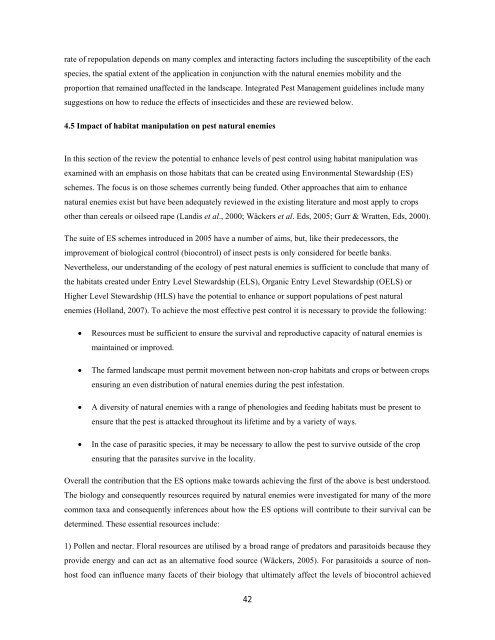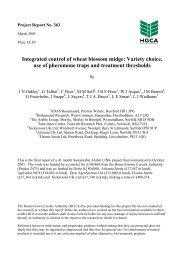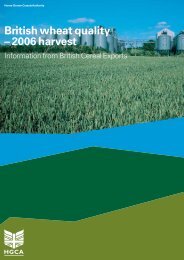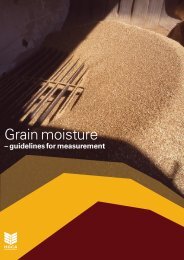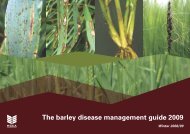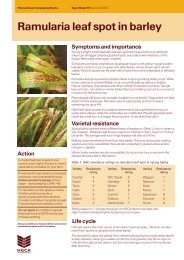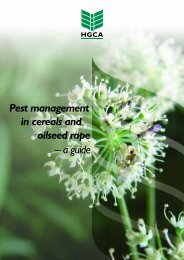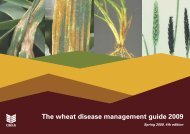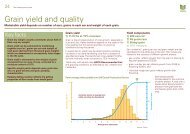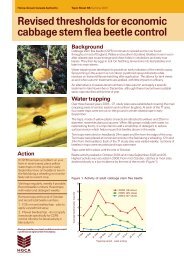Importance of arthropod pests and their natural enemies - HGCA
Importance of arthropod pests and their natural enemies - HGCA
Importance of arthropod pests and their natural enemies - HGCA
You also want an ePaper? Increase the reach of your titles
YUMPU automatically turns print PDFs into web optimized ePapers that Google loves.
ate <strong>of</strong> repopulation depends on many complex <strong>and</strong> interacting factors including the susceptibility <strong>of</strong> the eachspecies, the spatial extent <strong>of</strong> the application in conjunction with the <strong>natural</strong> <strong>enemies</strong> mobility <strong>and</strong> theproportion that remained unaffected in the l<strong>and</strong>scape. Integrated Pest Management guidelines include manysuggestions on how to reduce the effects <strong>of</strong> insecticides <strong>and</strong> these are reviewed below.4.5 Impact <strong>of</strong> habitat manipulation on pest <strong>natural</strong> <strong>enemies</strong>In this section <strong>of</strong> the review the potential to enhance levels <strong>of</strong> pest control using habitat manipulation wasexamined with an emphasis on those habitats that can be created using Environmental Stewardship (ES)schemes. The focus is on those schemes currently being funded. Other approaches that aim to enhance<strong>natural</strong> <strong>enemies</strong> exist but have been adequately reviewed in the existing literature <strong>and</strong> most apply to cropsother than cereals or oilseed rape (L<strong>and</strong>is et al., 2000; Wäckers et al. Eds, 2005; Gurr & Wratten, Eds, 2000).The suite <strong>of</strong> ES schemes introduced in 2005 have a number <strong>of</strong> aims, but, like <strong>their</strong> predecessors, theimprovement <strong>of</strong> biological control (biocontrol) <strong>of</strong> insect <strong>pests</strong> is only considered for beetle banks.Nevertheless, our underst<strong>and</strong>ing <strong>of</strong> the ecology <strong>of</strong> pest <strong>natural</strong> <strong>enemies</strong> is sufficient to conclude that many <strong>of</strong>the habitats created under Entry Level Stewardship (ELS), Organic Entry Level Stewardship (OELS) orHigher Level Stewardship (HLS) have the potential to enhance or support populations <strong>of</strong> pest <strong>natural</strong><strong>enemies</strong> (Holl<strong>and</strong>, 2007). To achieve the most effective pest control it is necessary to provide the following:• Resources must be sufficient to ensure the survival <strong>and</strong> reproductive capacity <strong>of</strong> <strong>natural</strong> <strong>enemies</strong> ismaintained or improved.• The farmed l<strong>and</strong>scape must permit movement between non-crop habitats <strong>and</strong> crops or between cropsensuring an even distribution <strong>of</strong> <strong>natural</strong> <strong>enemies</strong> during the pest infestation.• A diversity <strong>of</strong> <strong>natural</strong> <strong>enemies</strong> with a range <strong>of</strong> phenologies <strong>and</strong> feeding habitats must be present toensure that the pest is attacked throughout its lifetime <strong>and</strong> by a variety <strong>of</strong> ways.• In the case <strong>of</strong> parasitic species, it may be necessary to allow the pest to survive outside <strong>of</strong> the cropensuring that the parasites survive in the locality.Overall the contribution that the ES options make towards achieving the first <strong>of</strong> the above is best understood.The biology <strong>and</strong> consequently resources required by <strong>natural</strong> <strong>enemies</strong> were investigated for many <strong>of</strong> the morecommon taxa <strong>and</strong> consequently inferences about how the ES options will contribute to <strong>their</strong> survival can bedetermined. These essential resources include:1) Pollen <strong>and</strong> nectar. Floral resources are utilised by a broad range <strong>of</strong> predators <strong>and</strong> parasitoids because theyprovide energy <strong>and</strong> can act as an alternative food source (Wäckers, 2005). For parasitoids a source <strong>of</strong> nonhostfood can influence many facets <strong>of</strong> <strong>their</strong> biology that ultimately affect the levels <strong>of</strong> biocontrol achieved42


